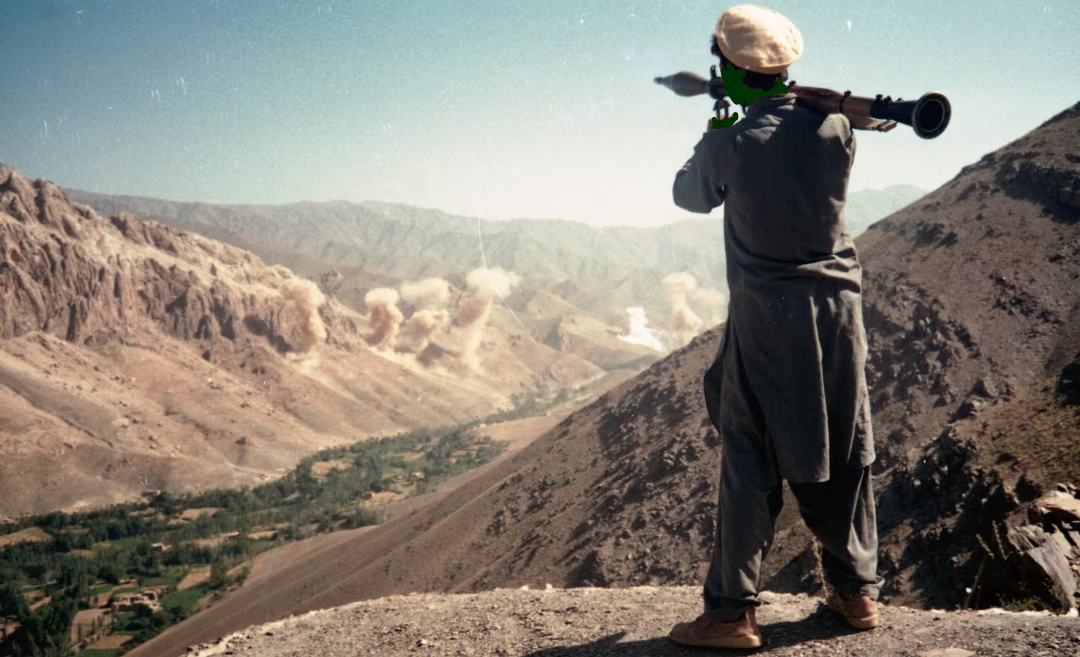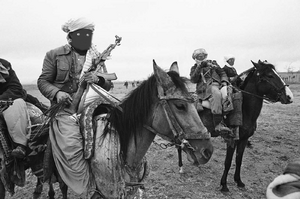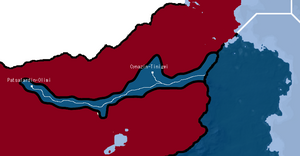Vagani Campaign
The Vagani campaign was a conflict lasting from 2146-2153 in the Vagani region west of Sahrland. The conflict began as the newly formed United front, consisting of what remained of the Labour party and National Salvation party, attempted to march into the Vagani region to recruit tribesmen and grind the Republicans down in a war of attrition. The campaign caused the temporary occupation by the Sahren Republican guard of the region of Vagani. The war was primarily fought by the United front with small ambushes and skirmishes and the Republicans by search and destroy missions. Significant numbers of local tribesmen were involved in the conflict as well. A superior base of supplies, air support, manpower, and fuel were the main causes of Republican victory.
Course of the war
Background
The aftermath of Operation Heteroatom and Operation Tetraethyllead left the United front in a state of disorganized retreat as they no longer held any significant production facilities or access to the coast. The death of Anastasia Otsahrlandiagorodtsev left Gerbin Ostalost as the most influential figure in the United front, and he decided the only way to win would be to fight a guerilla war in the Vagani region so the Republicans would have to fight the local tribes. The hope was that by prolonging the war, the factions inside the Republican coalition would eventually tear it apart and give the United front a chance to re-enter the Sahren Civil war.
Retreat
The disorderly retreat helped to confuse the Republican Guard Air-corp which were cautious not to attack potential civilians because the war was officially over. Disbanding of the Sahren Republican Militia left only the Sahren Republican Guard able to pursue the enemy. Although these were the most elite of the Republican forces, they lacked the numbers and initiative to properly take advantage of the situation. By the end of maeílhtyk all the remaining United front soldiers were no longer within Sahrland.
Skirmish at Kyzets mountain
As the Army of the United front withdrew, the Sahren Republican Guard under Karlo Frakchiya was ordered to pursue them. The United front was still disorganized and Ostalost was traveling with the 14th Divizi National Salvacion and the remains of the 7th Divizi National Salvacion Militziya, along with two Strecha briogades, which were spotted moving through Kyzets mountain to collect water by a Republican reconnaissance plane. The 5th Divizi Dragoons Militziya (which was transferred from the militia to bolster Frakchiya's forces) were ordered to rush forward and launch a probing attack against the United front. This dragoon division was chosen as they did not need fuel which was in short supply. The Dragoons were spotted and the United front forces set up temporary defensive positions on the mountain. The dragoons were not trained for mountain warfare and did not have winter clothing, resulting in heavy casualties from both enemy fire and frostbite. Both sides retreated with minimal results, however Ostalost became hypothermic in the mountain and had to temporarily relinquish command to General Yudzhin-kæ Argun while he recovered.
Battle of Cynazdin-Tinigwi
By Glapesch of 2147 The United front had recruited several of the Ak-At tribe to fight against the Sahren Republican invaders. With their numbers bolstered, the United front planned to engage the Republican Guard at the small town of Cynazdin-Tinigwi while the Ak-At Dragoons launched a surprise attack on the Republican flank. The Republican Guard still suffered from fuel shortages, so air support was very limited. In total there were 13 United front divisions numbering 98,000 and 8 Republican Guard divisions numbering 78,000. The Ak-At had a force of 18,000 Dragoons prepared to attack the flanks and destroy supply lines of the Republican Guard. The Republican Guard were outnumbered but they had superior numbers of Armour. The United front allowed the Republicans to enter so they could choose to engage the most vulnerable fire teams before retreating again. The battle continued for 28 days before the Ak-At launched their attack, forcing a Republican retreat from the city so they would not be cut off. This failure proved to the local tribes that the Republicans could be beaten with proper strategy, but it was deceitful as the Republicans were able to recover quicker as they had better access to medical equipment. General Karlo Frakchiya was recalled due to injury in the field by Shrapnel and was replaced with general Arkyn Yuari. It is believed this loss killed his military career but started his political career as the populace viewed the injury as heroic.
The Republicans returned to Cynazin-Tinigwi in early Vemáey of the same year. Yuari's new command did not hesistate to leverage their superior firepower. The Republican Guard fought against the heavily entrenched enemy for 42 days before the United front and tribal forces withdrew. Fuel shortages were still a signficant factor in the battle, as the Republican close air support were not permitted to spend long in the skies waiting for targets and were not permitted to use afterburners. The city was occupied for the duration of the campaign and an airfield erected to transport supplies and personelle by air. By the end of the battle 7,500 United front were killed, 700 wounded, and 1213 captured. Republicans suffered 3,800 killed and 12,300 wounded. Tribal casualties are unknown but are officially placed at around 10,000 total.
Withdrawal
In 2153 President Frakchiya proposed a vote in pairliament to withdraw from the Vagani region on the basis that the United Front was weakened beyond relevancy. The vote passed with 27 supporting, 2 against, and 1 abstained. As soon as the withdrawal was declared the guerilla campaign escalated dramatically. Despite press censorship news still reached the public that the war was finally coming to an end. Within 68 days the SRG retreated to Cynazdin-Tinigwi, from which they were transferred via air into Slovale. In order to prevent local tribes or the United front from taking over the airfield the Republican guard planted explosives. After the last refugee plane took off, they were detonated which resulted in the deaths of at least 13 civilians and injurring of 47.
Consequences
Casualties
It is generally accepted that 12,000 of the United front were killed, 1,250 were wounded, and 8000 were captured. The Republican Guard suffered 5,000 killed and 16,500 wounded, however superior prescence of medical equipment caused a majority of Republican wounded capable of returning to service. Local tribes are officially listed as 15,000 killed but this number is heavily disputed.
damages
In the course of the war the already crumbling Patsalardin-Olimi Cynazin-Tinigwi highway was almost completely destroyed. Artillery and close air support left so many craters that it was nearly useless. Nitrogen from shells distributed itself into the churned up rocks and soil causing the highway to bloom with flowers and grasses which became a symbol of peace and forgiveness. the city of Patsalardin-Olimi was also bombarded but the lack of a major battle prevented major damages. Cynazin-Tinigwi was almost entirely depopulated. A large crater was formed after the withdrawal which filled with water in the coming rains, becoming known as the "Lake of the forgotten" (Kel Umitilgandardin).


